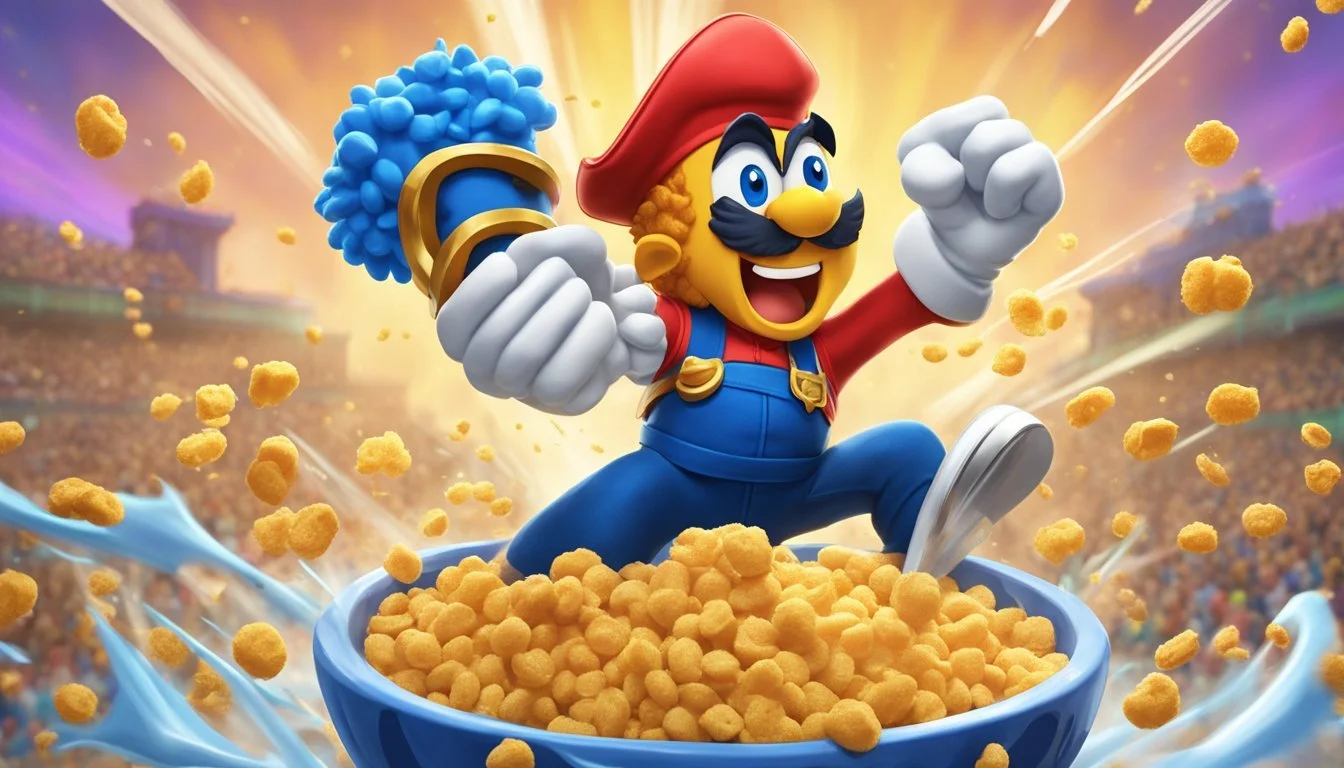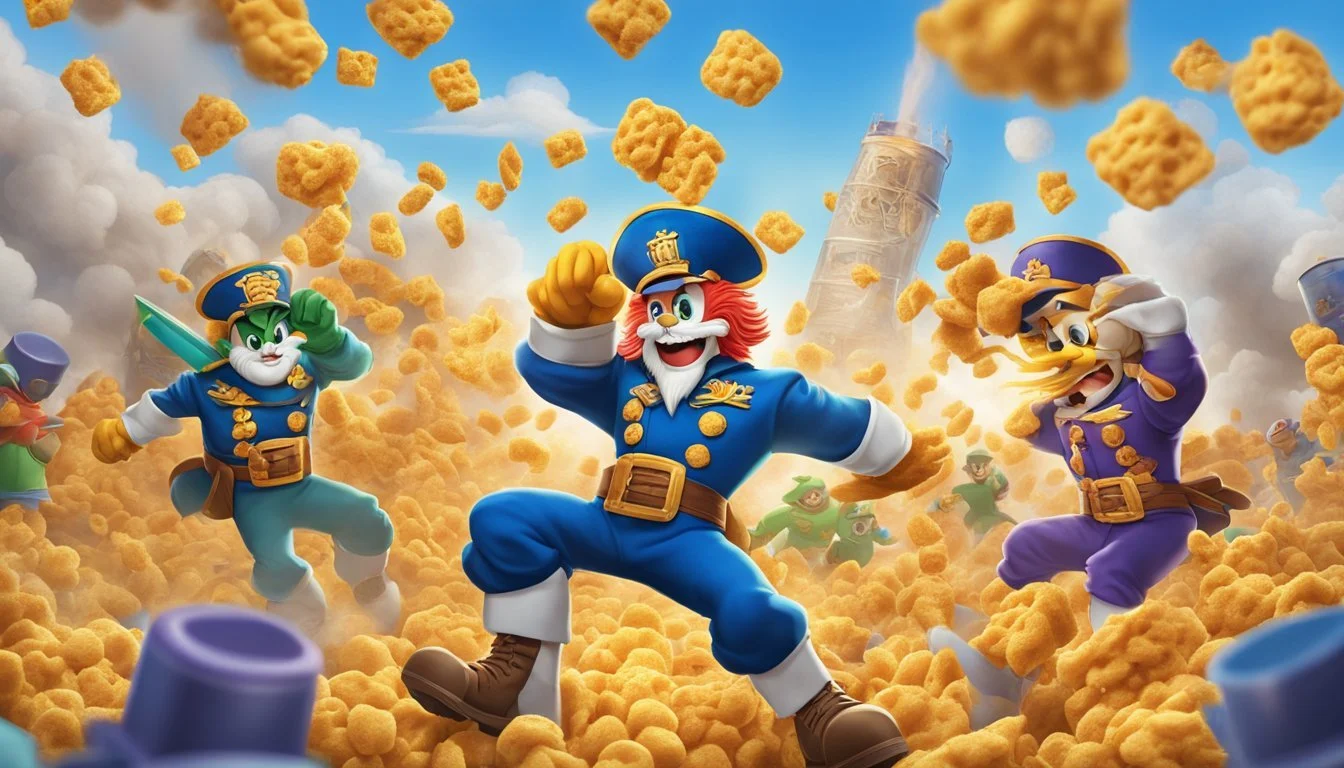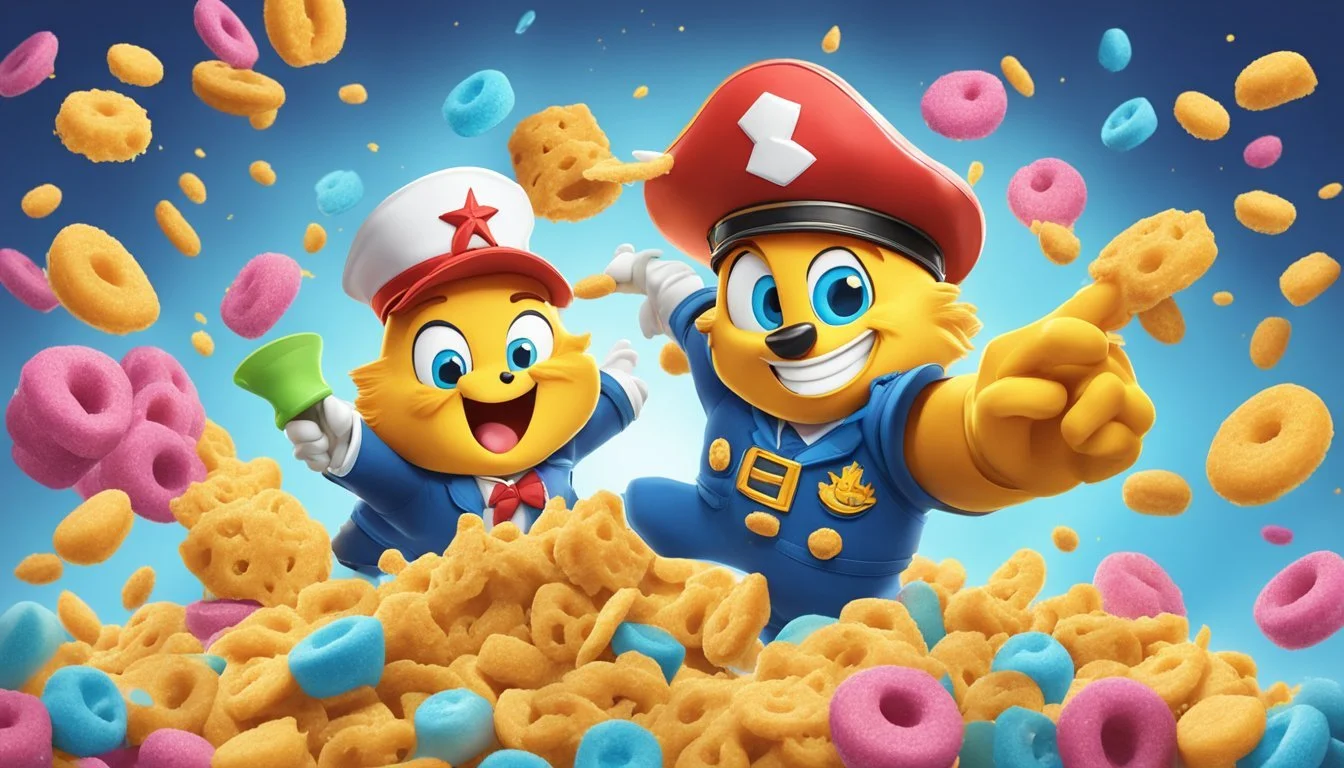Cap'n Crunch vs Kaboom
Battle of the Breakfast Cereals
This Article is Part of Our Breakfast Cereal Guide with Details on Cap'n Crunch Nutrition and Kaboom Nutrition
Cap'n Crunch and Kaboom, two nostalgic cereals, have been breakfast favorites for decades, each bringing its unique flair to morning routines. Cap'n Crunch, introduced by the Quaker Oats Company in 1963, stands out with its captain character and signature crunch that has captivated several generations. Kaboom, on the other hand, hit the shelves in 1969 with its circus clown mascot and bright marshmallow pieces, delighting kids with a splash of color and fun each morning.
While both cereals have their dedicated fan bases, there are marked differences in their flavors and staying power. Cap’n Crunch's original variety offers a buttery, crunchy texture that's been the cornerstone of its success. Kaboom, known for its clown-faced puffs and marshmallow stars, struggled to maintain its presence and eventually disappeared from grocery stores despite its colorful appeal.
For cereal enthusiasts looking to explore classic breakfast options, comparing Cap'n Crunch and Kaboom reveals how marketing, flavor profiles, and brand longevity play crucial roles in a cereal's lifetime. Sifting through their histories and taste profiles offers a journey through breakfast nostalgia and the ever-changing cereal landscape.
History and Evolution of Cap'n Crunch
Cap'n Crunch, introduced in 1963 by the Quaker Oats Company, has become a significant part of breakfast history. It has seen a vast expansion with numerous flavor variations and seasonal offerings over the years.
Origins and Brand Development
Cap'n Crunch was created by the Quaker Oats Company in 1963. The original flavor, devised by flavorist Pamela Low, was inspired by her grandmother’s recipe using brown sugar and butter over rice. This iconic combination resulted in a sweet, crunchy cereal that quickly gained popularity.
The mascot, Cap'n Crunch, was designed as a naval captain with a distinctive blue uniform and bushy mustache, aimed at capturing the imagination of young cereal enthusiasts. His commanding presence and appealing persona solidified Cap'n Crunch as more than just a cereal but a character that many children grew up with, adding a sense of nostalgia.
Variations and Expansion
Over the years, Cap'n Crunch has expanded its product line significantly. The original corn and oat cereal laid the groundwork for several flavor innovations. Notable among them are Crunch Berries, introduced in 1967, which added a fruity twist to the classic crunch.
Another popular variation is Peanut Butter Crunch, which offers a unique blend of peanut butter flavor with the distinct crunch. Seasonal and limited-edition flavors have also been introduced to keep the brand fresh and exciting for both new and loyal customers. Despite the new additions, the original flavor remains a beloved staple.
The expansion of the Cap'n Crunch brand reflects its ability to evolve while staying true to its roots, maintaining its reputation as a favorite breakfast choice for generations.
The Story of Kaboom
Kaboom cereal made its debut in 1969 and was produced by General Mills.
The cereal was easily recognizable with its nameless circus clown mascot, aimed at attracting children. The cereal itself featured bright, colorful clown faces and marshmallow stars.
Kaboom managed to hold its place on grocery store shelves for over 40 years, which is notable in a saturated cereal market.
Though never as prominent as other marshmallow-filled cereals like Lucky Charms, Kaboom developed a loyal following.
It competed with other popular cereals of the time such as Fruity Pebbles and maintained a unique identity with its circus theme.
The story of Kaboom is also a reminder of how cereals often had strong ties to character mascots and clever marketing.
Cereal Composition and Nutrition
Cap'n Crunch and Kaboom are popular cereals known for their distinct flavors. Below, you'll find a detailed look into the ingredients and nutrition of each cereal, highlighting key components and benefits.
Cap'n Crunch's Ingredients and Benefits
Cap'n Crunch is made mainly from corn and oats. The primary ingredients include corn flour, oat flour, sugar, and brown sugar. Butter and artificial flavorings are added for taste. Each serving contains about 4.5 teaspoons of sugar, contributing to its sweet profile.
Nutritionally, Cap'n Crunch provides zinc and phosphorus. It's not known for its health benefits but offers some essential nutrients. Iron and folate can also be sourced from this cereal, albeit in smaller amounts compared to more fortified cereals. Its taste makes it a favorite among children, although it's crucial to consume it in moderation due to its sugar content.
Kaboom's Nutritional Profile
Kaboom, on the other hand, emphasizes a unique blend of ingredients. This cereal includes corn, oats, and barley flour, with a recipe focusing on whole grains. Unlike Cap'n Crunch, Kaboom incorporates a variety of vitamins such as Vitamin B12, Vitamin B6, and Iron.
Kaboom is not only high in essential vitamins but also provides fiber, making it a slightly healthier option. It is gluten-free, catering to those with gluten sensitivities. The cereal is fortified to support daily nutritional requirements, giving it an edge in terms of nutrient density. Like Cap'n Crunch, it must be consumed habitually within a balanced diet due to its sugar content.
Marketing and Advertising Strategies
Cap'n Crunch's marketing strategies have long relied on their charismatic mascot to appeal to both children and adults. Their innovative campaigns have kept them relevant in the competitive cereal market.
Cap'n Crunch Campaigns
Cap'n Crunch, introduced by Quaker Oats in 1963, features a naval captain mascot that has become a beloved figure. With the tagline "Stays Crunchy Even in Milk," the brand's advertising emphasized the cereal's unique texture.
Television commercials often featured the Cap'n thwarting villains like Jean LaFoote, enhancing the cereal’s adventurous appeal. These ads were colorful and lively, catching the eyes of young viewers.
In addition to traditional TV spots, Cap'n Crunch leveraged digital marketing to engage with a tech-savvy audience. They launched interactive websites and social media campaigns to maintain brand interest. Cap'n Crunch's use of limited-edition flavors also created buzz, ensuring frequent product mentions.
Moreover, cross-promotions with other popular cereals, reminiscent of Toucan Sam and Cookie Crook, have further solidified the Cap'n Crunch brand. Through continuous innovation in marketing approaches, Cap'n Crunch remains a firm favorite in households. Their strategic mix of traditional and digital techniques ensures they stay ahead in the crowded cereal market.
Mascots and Character Development
Both Cap'n Crunch and Kaboom offer unique insights into the development of cereal mascots. While Cap'n Crunch has a rich backstory and a well-defined crew, Kaboom's iconography presents a distinct style that sets it apart in the cereal world.
Cap'n Crunch's Crew and Image
Cap'n Crunch, created by Allan Burns, is a commanding figure with a rich naval persona. His classic blue uniform, adorned with gold epaulettes, and white mustache characterize his stern yet approachable look.
He commands a crew that includes characters like Sea Dog, a loyal companion, and Jean LaFoote, a rival pirate, enhancing the storyline. The details in Cap'n Crunch's design reflect a meticulous effort to appeal to children while ensuring the character remains memorable for decades.
Iconography of Kaboom
Kaboom's mascot differs significantly, featuring a clown with bright colors and a playful demeanor. The emphasis on vibrant imagery and exaggerated features makes it stand out on the shelf.
Kaboom's iconography includes elements like balloons and circus themes, which attract a younger audience. This playful design contrasts sharply with the disciplined, naval theme of Cap'n Crunch, showcasing the diverse approaches in cereal mascot development.
Consumer Engagement and Nostalgia
Cap'n Crunch and Kaboom cereals have leveraged nostalgia to foster consumer engagement. This connection influences purchasing behaviors, driven by childhood memories and marketing strategies.
Fond Memories of Cap'n Crunch
Cap'n Crunch invokes strong childhood memories. Iconic cereal boxes and the distinct character of Cap'n Crunch captivate consumers.
Many people reminisce about weekend mornings spent pouring Cap'n Crunch while watching Saturday cartoons.
The nostalgia surrounding Cap'n Crunch is evident on platforms like YouTube. Users share stories and recipes involving this classic cereal, keeping its legacy alive.
The Enduring Legacy of Kaboom
Kaboom has a unique position in the nostalgia market. Though less famous than Cap'n Crunch, it still holds a special place for many who grew up in the '70s and '80s.
Bright colors and clown mascot made Kaboom boxes memorable. Children who enjoyed Kaboom then now seek it out as adults, driven by fond memories.
Even though Kaboom is no longer widely available, its nostalgic appeal persists. Occasionally, collectors and niche markets revive interest in the brand, showcasing its lasting impact on consumer behavior.
Product Availability and Purchase Locations
Cap'n Crunch and Kaboom cereals are widely available in many locations, including large grocery chains and online marketplaces. Their availability may vary depending on the region and store, but both brands have a strong retail presence.
Retail Presence of Cap'n Crunch
Cap'n Crunch, produced by Quaker Oats, is a familiar sight on cereal aisles across the United States.
Available flavors include Original, Peanut Butter Crunch, and Crunch Berries. Large retailers like Walmart, Target, and major grocery chains stock various Cap'n Crunch products. Consumers can find these cereals in the breakfast aisle, often stacked prominently alongside other popular brands.
Online shopping offers additional accessibility. Websites like Amazon and Walmart.com allow customers to purchase Cap'n Crunch products for home delivery or in-store pickup. This ease of access ensures Cap'n Crunch remains a convenient and popular choice for breakfasts and snacks.
Where to Find Kaboom Cereals
Kaboom cereals, although less ubiquitous than Cap'n Crunch, maintain a niche market presence.
Produced by General Mills, Kaboom cereals can be found in some grocery stores and select Walmart locations. Their availability may be more limited, often necessitating a search in stores known for carrying a broad range of cereal brands.
Online platforms like Amazon feature Kaboom for purchase, offering a solution for consumers in areas where the cereal is less readily available. In summary, while Kaboom's retail presence is more sporadic, options exist for those determined to enjoy this nostalgic cereal either locally or online.
Industry Impact and Cereal Comparison
Cap'n Crunch has established a notable presence in the cereal industry with its diverse flavors and nostalgic appeal. Kaboom, though less mainstream, holds a unique place in cereal history, offering a contrasting approach.
Market Influence of Cap'n Crunch
Cap'n Crunch, produced by Quaker Oats, has solidified its place in the market with several flavors like Crunch Berries and Peanut Butter Crunch. These variations not only cater to different tastes but also maintain consistent popularity among consumers.
The bright packaging and memorable mascot have contributed significantly to its sustained market influence. Promotions and limited editions like Orange Creampop Crunch further stimulate consumer interest. Cap'n Crunch competes effectively against other sweet cereals such as Cinnamon Toast Crunch and Frosted Flakes, leveraging its versatile product formulations and nostalgic marketing.
Kaboom's Role in Cereal History
Kaboom, introduced by General Mills, carved out a niche with its colorful, clown-themed packaging and multicolored cereal. Although not as prevalent as Cap'n Crunch or Honey Nut Cheerios, Kaboom appealed to children with both its flavors and visual appeal.
While it doesn’t have the extensive variety of Cap'n Crunch, Kaboom’s sweet cereal formulation was a unique aspect during its peak years. Kaboom often relied on nostalgia and targeted promotions to maintain its presence, though it has largely faded from mainstream shelves compared to Cocoa Puffs and Froot Loops.










